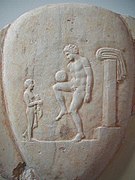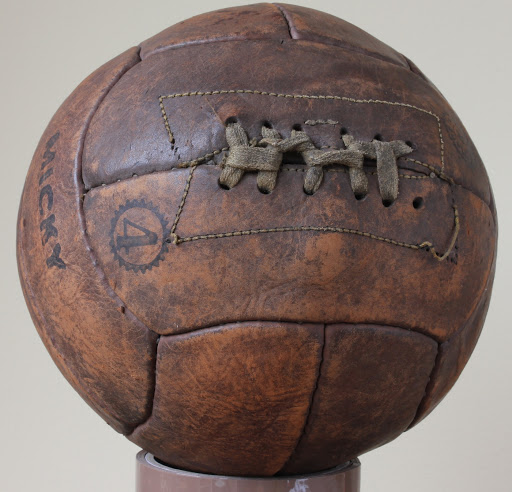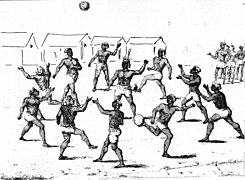
paragraph
1800s: During the 19th century football became extremely popular in Britain. People who played would wear their heavy and hard work boots to play. These were the first ever boots with the steel toe cap at the front, long laces and ankle support. These boots also had metal studs or tacks put in the sole the bottom so the players would have more stability on the pitch. In the later part of the 19th century the first ever football-specific boot was designed, made of thick and heavy leather which ran right to the ankle for increased protection; the first boot weighed 500 grams (18 oz) and would double in weight when it was wet.
1900–1940: During this period the style of football boots stayed very basic. They remained so during the inter-war years, despite many famous football boot producers, such as Gola, Hummel and Valsport becoming evermore popular.
1940–1960: After the Second World War, the designs of the football boot changed dramatically. The South Americans[specify] designed a lighter and more flexible boot. This design was focused on increasing good control and better kicking power rather than a more protective boot. In 1954 Adi Dassler introduced screw-in studs which gave the German team a tangible advantage during a rain-lashed World Cup that year. That Dassler was the first to come up with screw-in studs is disputed by his older brother, Rudolf Dassler, founder of Puma.
1960s: In the 1960s many football boots were designed with a lower cut. These enabled the best players in Europe and South America to move faster and change direction quicker. Mitre, Joma and Asics joined the fray.
1970s: The 1970s and the 1980s saw many large advances and changes in the football boot design. These included lighter boots and a variety of colours. Boot sponsorship also became more widespread. Adidas was the market leader in this period. At the end of the decade, in 1979, it cemented its status by releasing what has gone on to become the best selling boot of all time, the Copa Mundial. During this time period, some of the most common types of natural leather came into production: kangaroo leather, calfskin and full-grain/cow leather. Diadora entered the market in this decade.
1980s: Umbro, Lotto and Kelme joined the market in this decade.
1990–2000s: New types of sole were introduced to increase the balance of the player. The Adidas Predator, designed by Australian Craig Johnston in the late 1980s, was released in 1994 and enjoyed instant success. In the first decade of the 21st century laser technology was introduced to produce the first fully customised football boot in 2006.
2010s: In the era of the modern game that sees the tempo of matches becoming faster and players more technically inclined, manufacturers introduce new advances in technology including lighter footwear made from alternative materials.

The Ancient Greeks and Romans are known to have played many ball games, some of which involved the use of the feet. The Roman game harpastum is believed to have been adapted from a Greek team game known as "ἐπίσκυρος" (Episkyros) or "φαινίνδα" (phaininda), which is mentioned by a Greek playwright, Antiphanes (388–311 BC) and later referred to by the Christian theologian Clement of Alexandria (c. 150 – c. 215 AD). These games appear to have resembled rugby football. The Roman politician Cicero (106–43 BC) describes the case of a man who was killed whilst having a shave when a ball was kicked into a barber's shop. Roman ball games already knew the air-filled ball, the follis. Episkyros is recognised as an early form of football by FIFA.[27]
paragraph

The ball is spherical with a circumference of between 68 and 70 cm (27 and 28 in), a weight in the range of 410 to 450 g (14 to 16 oz), and a pressure between 0.6 and 1.1 standard atmospheres (8.5 and 15.6 pounds per square inch) at sea level. In the past the ball was made up of leather panels sewn together, with a latex bladder for pressurisation but modern balls at all levels of the game are now synthetic.[86][87]

There are a number of references to traditional, ancient, or prehistoric ball games, played by indigenous peoples in many different parts of the world. For example, in 1586, men from a ship commanded by an English explorer named John Davis, went ashore to play a form of football with Inuit (Eskimo) people in Greenland. There are later accounts of an Inuit game played on ice, called Aqsaqtuk. Each match began with two teams facing each other in parallel lines, before attempting to kick the ball through each other team's line and then at a goal. In 1610, William Strachey, a colonist at Jamestown, Virginia recorded a game played by Native Americans, called Pahsaheman. On the Australian continent several tribes of indigenous people played kicking and catching games with stuffed balls which have been generalised by historians as Marn Grook (Djab Wurrung for "game ball"). The earliest historical account is an anecdote from the 1878 book by Robert Brough-Smyth, The Aborigines of Victoria, in which a man called Richard Thomas is quoted as saying, in about 1841 in Victoria, Australia, that he had witnessed Aboriginal people playing the game: "Mr Thomas describes how the foremost player will drop kick a ball made from the skin of a possum and how other players leap into the air in order to catch it." Some historians have theorised that Marn Grook was one of the origins of Australian rules football.